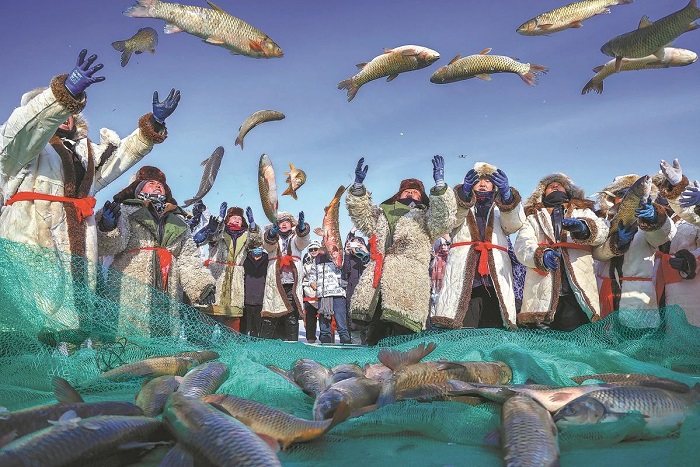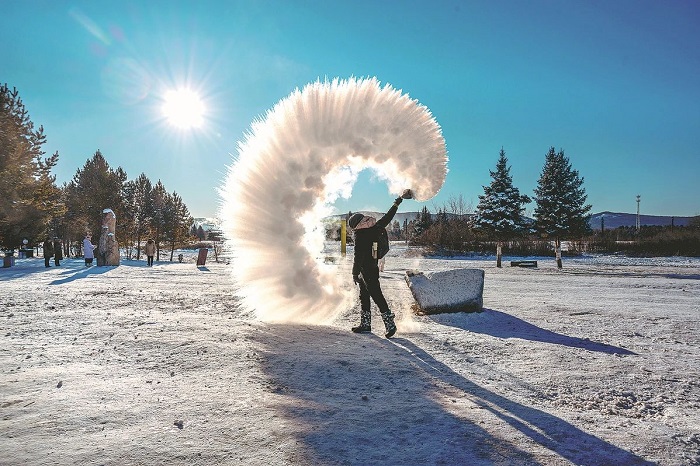Legacy of 2022 Games boosts enthusiasm for winter tourism
Li Yuanyuan, a photographer, has been working very hard over the past few weeks to help holidaymakers from across the nation capture their memorable moments in front of the Saint Sophia Cathedral, one of the iconic buildings in Harbin, Heilongjiang province.

▲Tourists and local residents take part in the annual winter large-net fishing ritual on Saturday at Bosten Lake, in the Bayingolin Mongol autonomous prefecture of the Xinjiang Uygur autonomous region. NIAN LEI/FOR CHINA DAILY
Having stayed in Harbin, often dubbed "China's ice city", for four years, the 23-year-old said he has never seen its streets "packed with so many people".
With temperatures dropping well below-20 C, Li said the city has been trying its best to offer visitors a warm and welcoming experience. "We have been trying to make our pricing as transparent as possible. Personal recommendation matters a lot in our business."
Over the past two months, winter tourism has been booming in Northeast China — Liaoning, Jilin and Heilongjiang provinces and part of the Inner Mongolia autonomous region — providing a much-needed boon as the region seeks new growth drivers and channels of job creation.
Analysts have highlighted an overarching vision from President Xi Jinping to get 300 million people involved in winter sports, set out during the bidding stages of the Beijing 2022 Winter Olympics, as playing a key role in driving public enthusiasm for winter tourism.

▲Hot water thrown into the air turns to ice in seconds in a village in the Greater Khingan Range of Heilongjiang province on Jan 15. MA ZHONGHAI/FOR CHINA DAILY
Xi has championed fully exploiting the nation's ice and snow resources, saying on multiple occasions that "ice and snow are also as valuable as gold and silver".
"The Beijing Winter Olympics and Paralympics are like a springboard that can propel the leapfrog development of winter sports and the ice and snow industry in our country," Xi told officials during a meeting in 2021 on the preparation of the two global events.
Han Yuanjun, an analyst at the China Tourism Academy, said, "Before the vision was set out by the president, few people could foresee the huge economic potential from the ice and snow sector."
The vision to bolster the growth of winter tourism has led regions with rich ice and snow resources, including Northeast China and the Xinjiang Uygur autonomous region, to come up with respective plans to improve their infrastructure and related sectors, he added.
This winter was the first time since the outbreak of COVID-19 that many Chinese tourists enjoyed their winter vacations without worrying about lockdowns and infections. It also saw the potential for winter tourism being fully unleashed across the nation.
During this year's New Year holiday, Heilongjiang was the destination of over 6.6 million tourist trips, a year-on-year increase of 173.7 percent, while Jilin saw an overall growth of 110 percent in tourism and Liaoning welcomed a total of 7.376 million tourist trips, representing a remarkable year-on-year growth of 203.8 percent.
The China Tourism Academy predicted in a recent report that the winter season from late 2023 to early 2024 will see traveler numbers exceed 400 million for the first time, bringing in tourism-related revenue of 550 billion yuan ($77.29 billion).
Han said the strong public enthusiasm for winter sports, part of the legacy of the Beijing Winter Olympics, coupled with the highly unique tourism resources in Northeast China, has contributed to the tourism boom.
Xi has made specific instructions on the development of winter tourism during fact-finding trips to Northeast China, highlighting the importance of "enabling the picturesque landscapes of the northern borderlands and the wealth of ice and snow resources to provide an inexhaustible source of income for the residents".
At a symposium in Harbin in September, he told officials that the region must vigorously develop tourism with distinctive features. Authorities in the northeast should treat the development of the ice and snow economy as a new growth point, promoting the development of whole industry chains, he added.
Another key factor that contributed to the success story of Harbin, and Northeast China in general, is the unwavering commitment from the authorities to provide a welcoming experience for tourists, analysts said.
During his trip to Heilongjiang in September, Xi set forth wide-ranging requirements for the region's authorities to improve the business climate, saying that a stable, transparent, regulated, and predictable legal environment must be created for various market entities.
Han, the analyst, said the unprecedented influx of tourists has presented the northeastern region's business environment with "an unprecedented test", both in terms of infrastructure and services.
In March 2019, Wang Wentao, the then governor of Heilongjiang, said that there were cases in which tourists were ripped off by service providers in the province, and the government set up a special fund to repay the tourists, even before the authorities launched investigations into the cases.
In one well-known case, a tourist complained in an online post about being ripped off by the owner of a family inn near Xuexiang National Forest Park, triggering an outcry about the tourism environment in the northeast.
With local authorities scaling up efforts to protect the interests of consumers and improve the business environment, the resort, also known as "China's Snow Town", has welcomed over 720,000 guests since November, with tourist numbers also expected to be record-breaking this winter.
The improvement in Harbin's business environment has been so dramatic that Luisa Tam, a columnist for the South China Morning Post, wrote that Hong Kong must look to the city for lessons to "attract tourists again".
Yuan Baohong, a regional economy analyst with market research firm CCID Consulting, said the authorities in Harbin and other northeast cities have devoted considerable efforts to providing tourists with a better travel experience, including free rides to scenic spots and a quick response to their complaints.
He explained that the booming winter tourism sector has also offered key lessons for the revitalization of the northeast, as the region grapples with challenges such as population outflows and economic slowdowns.
"The development of cultural and tourism sectors can serve as a gateway for fostering new growth drivers and developing new productive forces," Yuan said.
Reporter: Xu Wei, Zhou Huiying
